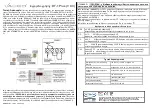
L-VIS User Manual
259
LOYTEC
Version 6.2
LOYTEC electronics GmbH
reasonable value which is not several days or even weeks old. This can especially be
important when the desired data cannot be retrieved at the moment it is requested, due to a
communication problem with the server.
NOTE:
Depending on the underlying network technology, inactive data points may still receive
event driven updates from other nodes, so dynamic polling has no effect on bound input
network variables on a CEA-709 network, for example.
11.5.4 OPC-XML-DA
For input data points which are using OPC-XML/DA to retrieve new data from the server,
there are two modes of operation available:
Polling:
Data is requested at a regular interval, which can be specified in the input
field called
OPC Pollcycle
.
Delayed Response:
An advanced algorithm to optimize latency and minimize
network traffic is applied. For this mode, a
Hold Time
and a
Wait Time
have to
be specified. The hold time specifies how long the server may hold back the
response and wait for additional value changes. This limits the maximum number
of responses, even if there are more value changes. The wait time comes into
effect when there is no value change to report during the hold time. It defines how
long the server should keep the request and send a delayed response if a value
change is detected. If there is no value change even during the wait time, the
request times out and an empty response is sent.
11.5.5 Auto-Convert to LWEB
This area is used to set up automatic generation of an LWEB project matching the current
L-Vis project. It can optionally be downloaded to the device together with the L-Vis
project, where it can be used by LWEB-800/802 clients to display the same project (as
currently running on the L-Vis device) also on the PC. The following settings are available:
Automatically save LWEB project:
This option must be enabled to make use of
any of the following options. When enabled, instructs the configuration software
to build and save an LWEB version of the project, whenever the L-Vis version is
saved. To do this automatically, the user needs to specify host name and port
number of the device which will be used by LWEB to fetch data point values:
o
Host:
In most cases, you can leave this at the default of
localhost
. This
will build an LWEB project which fetches the data points from the same
device from which the LWEB project was loaded, which is usually what
you want. Only in cases where the generated project will be loaded from
a central server instead of the L-Vis device, enter the name or address of
the L-Vis device which will run the original L-Vis project.
o
Port:
The port number for OPC access. Default is port 80.
Download together with L-Vis project:
Checking this option will instruct the
configuration software to download the automatically generated LWEB project
together with the L-Vis project, whenever a project download is executed. This
will make sure that the LWEB project on the device always matches the currently
running L-Vis project, which is important for the LWEB project to work.
Use .lweb2 file format:
This option will use the new .lweb2 file format instead
of the traditional .lweb format when building the LWEB project. You may turn
this option on if your LWEB-800 client already supports .lweb2 or if you are
testing the new LWEB-802 client software, which can only read .lweb2 files.
















































